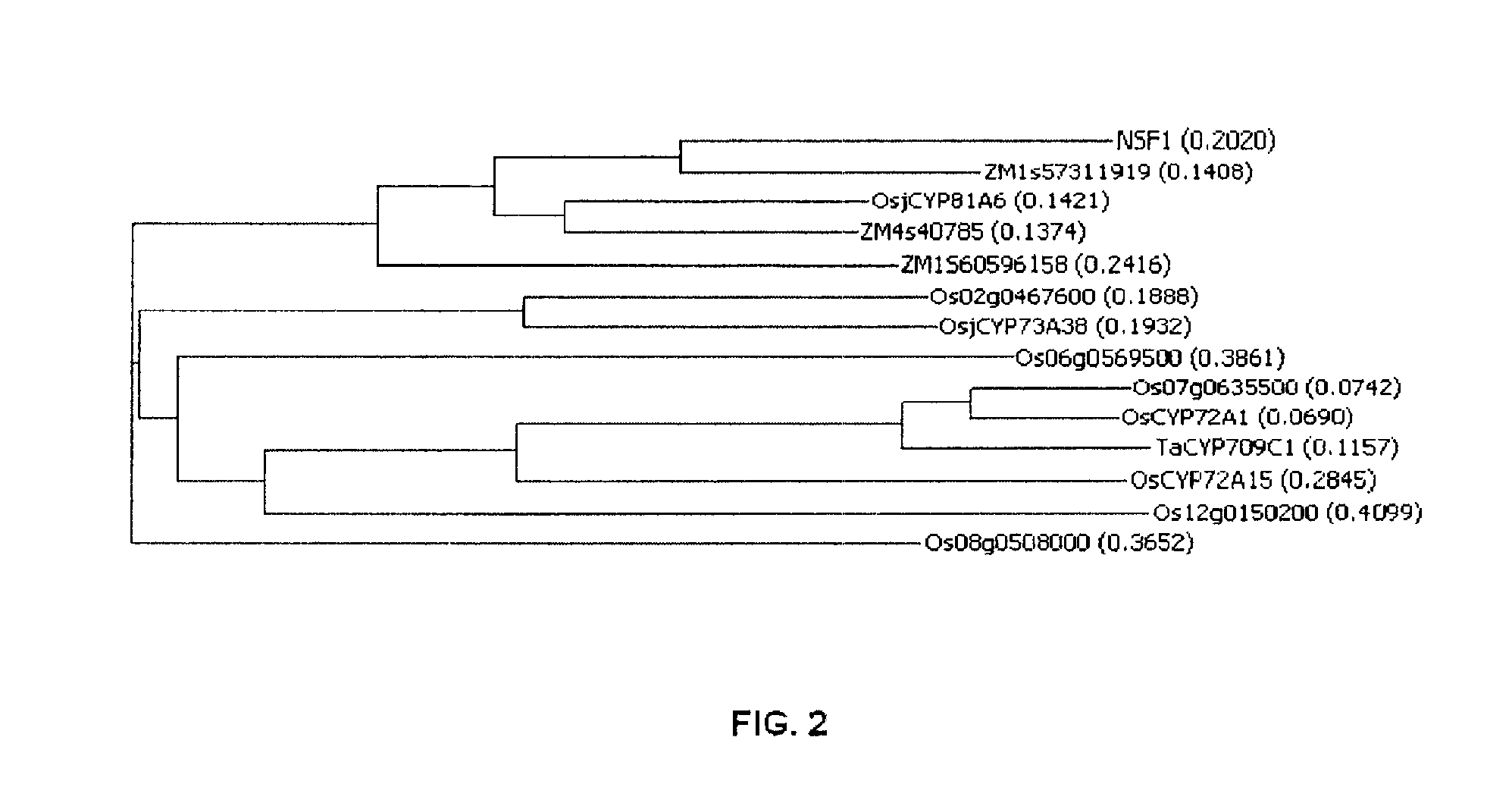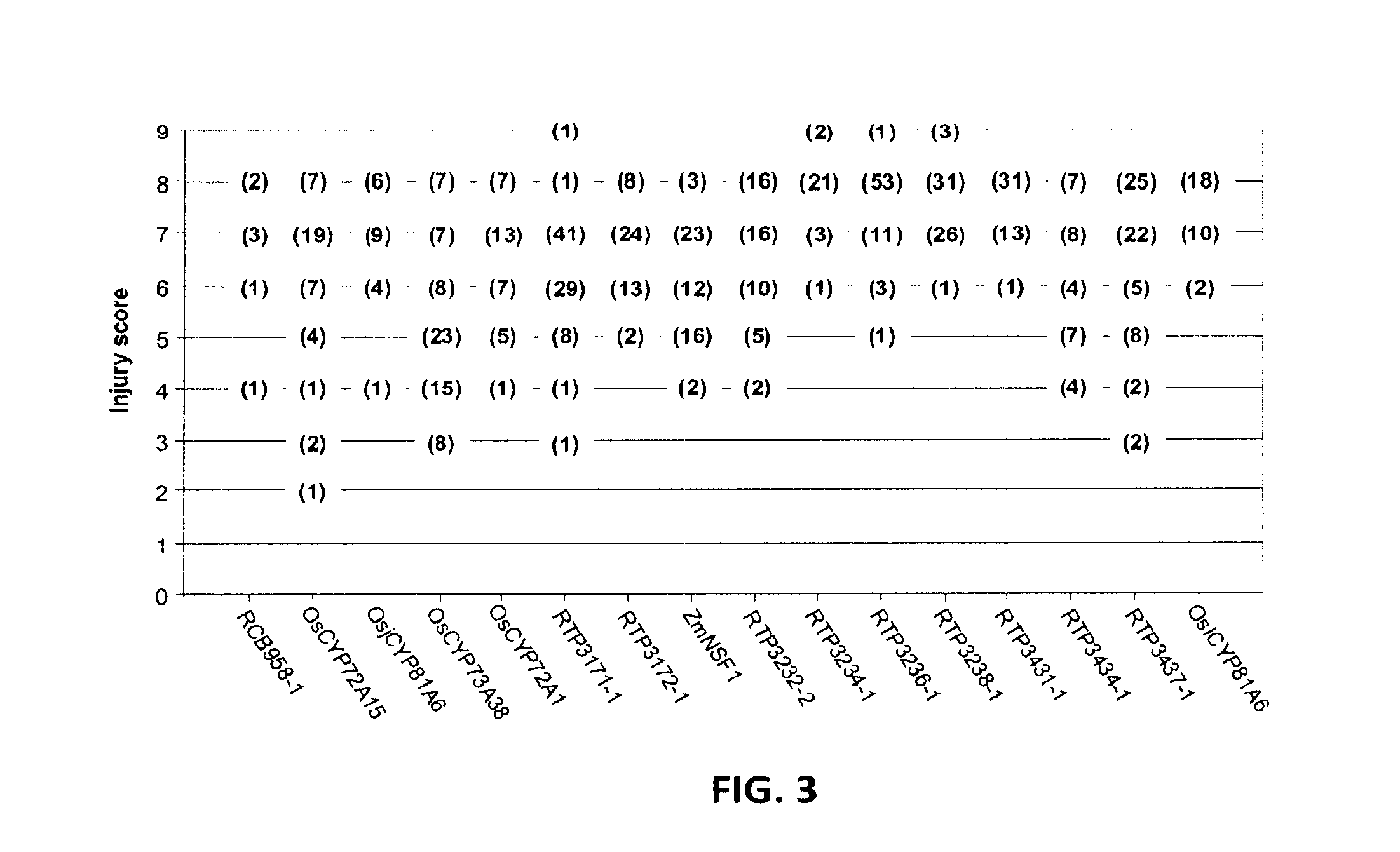Herbicide-tolerant plants
a technology of herbicides and plants, applied in the field of herbicide-tolerant plants, can solve the problems of rapid and significant crop injury, cell death, damage to cell membranes,
- Summary
- Abstract
- Description
- Claims
- Application Information
AI Technical Summary
Benefits of technology
Problems solved by technology
Method used
Image
Examples
example 1
Expression Analysis of Safener and Saflufenacil-Induced Monocot P450 Genes
[0219]Experiments were designed in rice, wheat, and maize to identify P450 genes induced by safener and / or saflufenacil application. Ten seeds were sown per 4 inch pot filled with Midwest soil and allowed to germinate for 4-5 days in standard greenhouse conditions. Once emergence from the soil was apparent, seedlings were sprayed according to the protocol shown in Table 15.
TABLE 15Spray protocol for wheat, rice, and maize seedlings used for P450expression analysis.methylatedsafenerseed oil(500 gsaflufenacilSampletreatmentadjuvantai / ha)(g ai / ha)wheat100020.1% v / v0030.1% v / vcloquintocet040.1% v / vdichlormid050.1% v / v040060.1% v / v080070.1% v / vcloquintocet40080.1% v / vcloquintocet80090.1% v / vdichlormid400100.1% v / vdichlormid800rice100020.1% v / v0030.1% v / vcloquintocet040.1% v / vdichlormid050.1% v / v040060.1% v / v080070.1% v / vcloquintocet40080.1% v / vcloquintocet80090.1% v / vdichlormid400100.1% v / vdichlormid800corn100020.1...
example 2
[0225]Maize immature embryos (ies: JHAX(HiIIXA188) were isolated from surface sterilized cobs (9-10 days post pollination) and cultured for 1 week on M-MS-101 media (Table 17).
TABLE 17Maize media.M-MS-M-LS-M-LS-M-LS-M-MS-R-N6-M-LS-M-LS-IngredientsSupplier101213513616710100002014MS SaltsPhytotech 4.3 g / L 4.3 g / L 4.3 g / L 2.4 g / L 4.3 g / L 4.3 g / L 4.3 g / LM-5524N6 SaltsDuchefa3.96 g / LN6 vitaminsDuchefa1x1000x solnSucroseVWR 30 g / L 20 g / L 30 g / L 20 g / l 30 g / L68.5 g / L 20 g / LGlucoseVWR 36 g / L 10 g / LMaltoseVWR 30 g / LCasaminoBD 300 mg / L 1 g / LAcidNicotinicSigma 0.5 mg / L 0.5 mg / L 0.5 mg / L 0.5 mg / L 0.5 mg / L 0.5 mg / LacidPyridoxineSigma 0.5 mg / L 0.5 mg / L 0.5 mg / L 0.5 mg / L 0.5 mg / L 0.5 mg / LHClThiamineSigma 1 mg / L 1 mg / L 1 mg / L 1 mg / L 1 mg / L 1 mg / LHClMyo-Sigma100 mg / L100 mg / L100 mg / L100 mg / L 100 mg / L100 mg / LinositolL-ProlineSigma 2.9 g / L700 gm / L700 gm / L1.16 g / L 2.9 g / L700 gm / LMESSigma500 mg / L500 mg / L500 mg / L 500 mg / L 500 mg / L500 mg / LCaseinSigma100 mg / L 1 g / LhydrolysateL-Sigma 150 mg / LAsparagin...
example 3
Maize Immature Embryo Transformation and Response to Herbicide
[0227]Immature Embryo Transformation: Immature embryos were transformed according to the procedure outlined in WO2006 / 136596 to Peng et al. The exception was that a proportion of the embryos—25 in most cases—were placed on media containing saflufenacil and kept in the light for direct selection. The remaining embryos in each experiment were selected on Pursuit as described. Plants were tested utilizing Taqman analysis with the target being the nos terminator which is present in all constructs. Healthy looking plants were sent to the greenhouse for hardening out and subsequent spray testing. As with the BMS cells, RCB958 was utilized as a control both for transformation, saflufenacil selection, and for spray testing.
[0228]A total of 82 transgenic maize plants (2 constructs of interest and 1 control construct) were delivered to the greenhouse in tissue culture. The plants were individually transplanted into MetroMix 360 soi...
PUM
| Property | Measurement | Unit |
|---|---|---|
| length | aaaaa | aaaaa |
| bioactive | aaaaa | aaaaa |
| residual activity | aaaaa | aaaaa |
Abstract
Description
Claims
Application Information
 Login to View More
Login to View More - R&D
- Intellectual Property
- Life Sciences
- Materials
- Tech Scout
- Unparalleled Data Quality
- Higher Quality Content
- 60% Fewer Hallucinations
Browse by: Latest US Patents, China's latest patents, Technical Efficacy Thesaurus, Application Domain, Technology Topic, Popular Technical Reports.
© 2025 PatSnap. All rights reserved.Legal|Privacy policy|Modern Slavery Act Transparency Statement|Sitemap|About US| Contact US: help@patsnap.com



